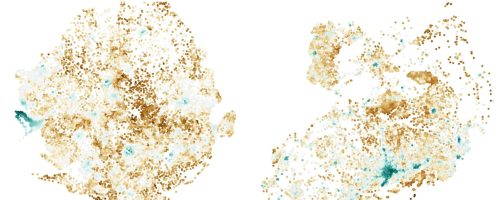Publication
Poverty maps are essential tools for governments and NGOs to track socioeconomic changes and adequately allocate infrastructure and services in places in need. Sensor and online crowd-sourced data combined with machine learning methods have provided a recent breakthrough in poverty map inference.
However, these methods do not capture local wealth fluctuations, and are not optimized to produce accountable results that guarantee accurate predictions to all sub-populations.
Here, we propose a pipeline of machine learning models to infer the mean and standard deviation of wealth across multiple geographically clustered populated places, and illustrate their performance in Sierra Leone and Uganda. These models leverage seven independent and freely available feature sources based on satellite images, and metadata collected via online crowd-sourcing and social media.
Our models show that combined metadata features are the best predictors of wealth in rural areas, outperforming image-based models, which are the best for predicting the highest wealth quintiles. Our results recover the local mean and variation of wealth, and correctly capture the positive yet non-monotonous correlation between them. We further demonstrate the capabilities and limitations of model transfer across countries and the effects of data recency and other biases.
Our methodology provides open tools to build towards more transparent and interpretable models to help governments and NGOs to make informed decisions based on data availability, urbanization level, and poverty thresholds.
L. Espín-Noboa, J. Kertész, M. Karsai, Interpreting wealth distribution via poverty map inference using multimodal data, WWW’23: Proceedings of the ACM Web Conference (2023) 4029-4040.
Related

Signup
| Cookie | Duration | Description |
|---|---|---|
| cookielawinfo-checkbox-analytics | 1 year | Set by the GDPR Cookie Consent plugin, this cookie records the user consent for the cookies in the "Analytics" category. |
| cookielawinfo-checkbox-functional | 1 year | The GDPR Cookie Consent plugin sets the cookie to record the user consent for the cookies in the category "Functional". |
| cookielawinfo-checkbox-necessary | 1 year | Set by the GDPR Cookie Consent plugin, this cookie records the user consent for the cookies in the "Necessary" category. |
| CookieLawInfoConsent | 1 year | CookieYes sets this cookie to record the default button state of the corresponding category and the status of CCPA. It works only in coordination with the primary cookie. |
| PHPSESSID | session | This cookie is native to PHP applications. The cookie stores and identifies a user's unique session ID to manage user sessions on the website. The cookie is a session cookie and will be deleted when all the browser windows are closed. |
| viewed_cookie_policy | 1 year | The GDPR Cookie Consent plugin sets the cookie to store whether or not the user has consented to use cookies. It does not store any personal data. |
| Cookie | Duration | Description |
|---|---|---|
| mec_cart | 1 month | Provides functionality for our ticket shop |
| VISITOR_INFO1_LIVE | 6 months | YouTube sets this cookie to measure bandwidth, determining whether the user gets the new or old player interface. |
| VISITOR_PRIVACY_METADATA | 6 months | YouTube sets this cookie to store the user's cookie consent state for the current domain. |
| YSC | session | Youtube sets this cookie to track the views of embedded videos on Youtube pages. |
| yt-remote-connected-devices | never | YouTube sets this cookie to store the user's video preferences using embedded YouTube videos. |
| yt-remote-device-id | never | YouTube sets this cookie to store the user's video preferences using embedded YouTube videos. |
| yt.innertube::nextId | never | YouTube sets this cookie to register a unique ID to store data on what videos from YouTube the user has seen. |
| yt.innertube::requests | never | YouTube sets this cookie to register a unique ID to store data on what videos from YouTube the user has seen. |
| Cookie | Duration | Description |
|---|---|---|
| _ga | 1 year | Google Analytics sets this cookie to calculate visitor, session and campaign data and track site usage for the site's analytics report. The cookie stores information anonymously and assigns a randomly generated number to recognise unique visitors. |
| _ga_* | 1 year | Google Analytics sets this cookie to store and count page views. |
| _gat_gtag_UA_* | 1 min | Google Analytics sets this cookie to store a unique user ID. |
| _gid | 1 day | Google Analytics sets this cookie to store information on how visitors use a website while also creating an analytics report of the website's performance. Some of the collected data includes the number of visitors, their source, and the pages they visit anonymously. |